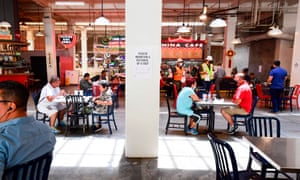‘Like leaning into a left hook’: coronavirus calamity unfolds across divided US
In a week that saw the worst day on record for new cases, Trump shrugs as experts warn Americans not to follow his lead

Photograph: Frederic J Brown/AFP/Getty Images
A disaster is unfolding in Montgomery, Alabama, where Martin Luther King preached and where Rosa Parks was arrested for refusing to give up her seat on the bus. Hospitals are running short of drugs to treat Covid-19, intensive care units are close to capacity, and ventilators are running short.
Between 85% and 90% of the very sick and dying are African American.
Amid this gathering storm, the city council met to decide whether to require people to wear masks, a basic protection the US Centers for Disease Control and Prevention (CDC) strongly recommends. Doctors lined up to plead their case.
“This is beyond an epidemic in this area,” said the pulmonologist Bill Saliski. “Our units are full of critically ill covid patients. We have to slow this down.”
His colleague, Nina Nelson-Garrett, described watching undertakers carrying out corpses, 30 minutes apart.
“Something as simple as a mask can save someone’s life,” she said.
Dr Kim McGlothan recounted how she was frequently stopped by white people asking, “Is the media sensationalizing this, is it really as bad as they are making out?”
McGlothan told the council: “People don’t believe the hype. Until you mandate masks, we won’t be able to stop this – we just won’t.”
Then a black resident stood up. Six of his relatives had died from Covid-19. His brother was on a ventilator. “This is not about masks,” he said. “The question on the table is, ‘Do black lives matter?’ I lost six of my family to Covid. How would it feel if it was your family?”
The council debated for two hours. White council members asked if young children could get carbon monoxide poisoning from masks – no, the doctors firmly told them – and spoke portentously about individual rights.
“At the end of the day,” said councilman Brantley Lyons, “if a pandemic comes through, we do not throw our constitutional rights out the window.”
When the vote was called, it divided on largely racial lines. Black members voted for masks, in order to prevent more families losing six loved ones. White members voted against masks, to preserve the fundamental right not to attach a cloth to your face.
In a 4-4 tie, the ordinance failed. As he left the chamber, Dr Saliski uttered just one word: “Unbelievable.”

Unbelievable accurately describes America today. The country is on the brink of a huge surge of Covid-19, as the virus tears through the heartlands while the president praises himself for having done “a great job” and blithely predicts the scourge will “fade away”.
Ask Alabama whether the virus is fading away. Or Arizona, Florida, South Carolina or Texas. The disease is venting its fury on these states, which all reopened their economies – with Donald Trump’s avid blessing – before the contagion was contained.
“Opening while cases are increasing is like leaning into a left hook,” said Tom Frieden, a former CDC director. “You are basically asking to get hit – and that’s what these states did.”
Alabama is enduring a pummeling. It has recorded 32,000 cases and its curve is on a steep upward path.
The Republican governor of Texas, Greg Abbott, who ushered in one of the earliest and most aggressive reopenings, insisted a few days ago that his state “remains wide-open for business”. Yet he has been unable to ignore reality: that the virus has spread its lethal tentacles to every corner of the state overwhelming hospitals to the point that Houston medical centers are running out of ICU beds. Now, once again, Texas’ bars are closing. One town, near Houston, has even brought in a curfew.
The Lone Star state recorded 6,584 cases on Wednesday alone – a heart-sinking figure that makes its curve look almost vertical.
Florida’s malaise would be wryly amusing were so many lives not at stake. On 20 May the conservative magazine the National Review ran the gloating headline: “Where Does Ron DeSantis Go to Get His Apology?” The article scolded liberal critics of the Republican governor’s lax approach to coronavirus – he famously allowed beaches to remain open in spring break and has permitted shops and restaurants to get back to business – for having got it wrong: there was no spike in Florida.
On 20 May, Florida’s daily infection load stood at 527 new cases. Five weeks later, it reported a record 8,942 on Friday and broke the record again on Saturday with 9,585.
‘It’s getting worse, not better’
Though states such as Florida and Texas are bearing the brunt of the beating, this is not a catastrophe that can be dismissed as the problem of just a few places. Across the nation, at terrifying speed, a similar picture is revealing itself.
Every important data point, including positivity rates and hospitalizations, is surging across most states. A map produced by a team of epidemiologists and health experts, Covid Act Now, shows only four states, all in the north-east, including New York, which used to be at the center of the pandemic but has wrestled it under control, as being on track to contain the disease. Twenty-one states are at risk or facing active or imminent outbreaks.
It is troubling enough that the US now has 2.4m confirmed cases – double the number of the next highest country in the world, Brazil, and almost certainly a huge underestimate. The death toll has passed 125,000, with another 20,000 at least expected this month.
The death rate is still trending downwards – one bit of positive news in this sorry picture. But deaths lag behind confirmed cases by a month, and that spells trouble ahead.
One crumb of comfort had been that for almost three months the daily rate of new infections held steady at around 20,000 cases a day. Then, two weeks ago, the monster began to stir.
The tally of new cases ticked upwards, and on Thursday it reached a stomach-churning 40,000 – the worst day on record since the pandemic began.
“It’s getting worse, not better,” said Frieden, who now heads the global health initiative Resolve to Save Lives. “The contrast with other countries is striking. South Korea had 30 cases a day and they flipped out. The US now has 30,000 cases a day and there are people shrugging and saying ‘It’s no big deal’.”

Trump is shrugger-in-chief. When the president lured thousands of non-mask wearing supporters to a viral incubation party – he called it a rally – in Tulsa, Oklahoma, last Saturday, he told them that in his view testing for coronavirus was a “double-edged sword… When you do testing you are going to find more cases. So I told my people, slow the testing down.”
Despite White House efforts to pass the comment off as a joke, it encapsulates the Trump administration’s approach towards this devastating crisis. Early on, Trump failed to marshal the full weight of the most powerful government on Earth against the virus. He lost six critical weeks.
Even today, the 500,000 tests being carried out each day falls woefully short of the scale needed. Contact tracing – another crucial tool – is patchy at best, with signs that a growing number of Americans are unwilling to cooperate.
Leading public health experts have watched aghast as Trump has done exactly what he said he would: put a dampener on data-driven efforts that could, over the course of the pandemic, potentially save hundreds of thousands of lives.
“Everybody agrees we need a lot more testing,” said Ashish Jha, director of the Harvard Global Health Institute. “But when the conversation turns to, ‘Why can’t we ramp up the testing?’ there’s always the sense that the White House is not going to be happy to do what’s necessary. There’s real pushback against scientific leaders calling for action.”
Evidence for such a pushback isn’t hard to find. There’s this week’s announcement that the Trump administration will soon end federal funding for 13 testing sites – seven in ravaged Texas.
Then there’s the ghostlike absence of the CDC, one of the world’s leading public health agencies, which has fallen mute at the moment it is most needed. Frieden has become so frustrated by the booming silence of the institution he led for almost eight years, until Trump entered the White House, he has taken to publicising CDC research himself, in a desperate attempt to fill the void.
When the Guardian put it to him that this was an extraordinary state of affairs, Frieden replied: “It feels a bit like North Korea, doesn’t it?”
The most worrying aspect of the tone being set by Trump is that it is starting to shift the mindset of ordinary Americans. Everywhere you look there are anecdotal signs of people falling in line with the president – shrugging and saying it’s no big deal.
That trend is very visible in Montgomery. In the end, the town’s African American mayor, Steven Reed, overruled the city council’s white members and introduced mandatory mask-wearing by executive fiat.
But it will be an uphill battle persuading white townsfolk to abide by the ordinance. Brad Harper, a reporter with the Montgomery Advertiser, says he is struck whenever he goes into a Target or Walmart that almost all white shoppers go unmasked while black shoppers have their faces covered.
On social media, people rant about masks as “muzzles” and “badges of submission”. “People get really angry about it, resisting even their doctors asking them to wear it,” Harper said. “They don’t see a protective device, as something that can save the people around you, they see it as an instrument of control.”

All across the country, similar acts of personal rebellion are playing out. Residents of Palm Beach, Florida, erupted in anger against a mandatory mask order, calling it the “devil’s law” and an affront to “God’s breathing system”.
Further up the Florida coast, in Jacksonville Beach, 16 friends decided to have a night out at an Irish pub – the entire group came down with the virus, as well as seven bar workers. A surprise birthday party in Texas led to 18 members of one family being infected.
Crowds of unmasked people have been gathering in Las Vegas’s reopened casinos, and Covid-19 cases have soared. In Arizona, the Republican sheriff of Pinal county vowed not to enforce the lockdown on grounds of individual liberty, and promptly contracted the disease himself. Not to mention Cruisin’ Chubbys Gentleman’s Club, a strip club in Wisconsin that had its very own outbreak.
‘If you divide people, you allow divide and conquer’
Everywhere you look there are indications America’s social contract – the idea that if we stand united we can defeat this terrible affliction – is breaking down.
“If you divide people, you allow divide and conquer,” Frieden said. “This is us against them, humans against microbes. The more we are divided, the more microbes will conquer.”
Wändi Bruine de Bruin, provost professor of public policy, psychology and behavioral science at the University of Southern California, has been tracking the changing public response since March. Through a rolling survey of 7,000 adults, she has found that most Americans – about 71% – still say they avoid public spaces and crowds. But the proportion is falling, fast, down from 92% in April.
She puts the slide down to unclear messaging. “Messages and policies are no longer consistent. Some businesses are allowed to open, others not, and it’s not clear why. That leads to confusion, and anger. Some people start to think it’s not fair, others start to assume it’s not that important.”
Jha said it was vital to acknowledge that most Americans, including many Republicans, have so far been compliant with stay-at-home orders. But he frets that a mindset is taking hold that the virus is somebody else’s problem.
“I worry that it will take large numbers of people getting very sick, the hospitals filling up, for people to realise this is a pandemic, not a disease outbreak in New York or New Orleans. I hope it doesn’t come to that. I worry that it will.”
The Guardian asked whether he was concerned about possible public resistance to renewed lockdown orders, should some states be forced back into extreme measures in the face of a Covid-19 explosion.
“I do fear that,” he said. “For months there has been a concerted effort by a small minority to argue that this is overblown or a hoax. It will be difficult for Republican leaders to get people to change their views on this.”
Jha checked himself, then added: “It’s a tiny minority. Unfortunately, it includes the president of the United States.”

The good news is that scientists are very clear about what needs to be done. Frieden calls it the three Ws – wear a mask, wash your hands, watch your distance – combined with aggressive testing, contact tracing and isolation of the sick.
If such measures can be introduced concertedly and quickly, both at federal and state level, public health experts are confident that all is not lost. The contagion could be contained and the economy slowly and relatively safely rebooted.
But time is running out for America.
“This is a long war and we are losing a lot of battles right now, because we are not fighting them,” Frieden said. “We are going to be paying for the mistakes we make today for months, or even years, to come.”



